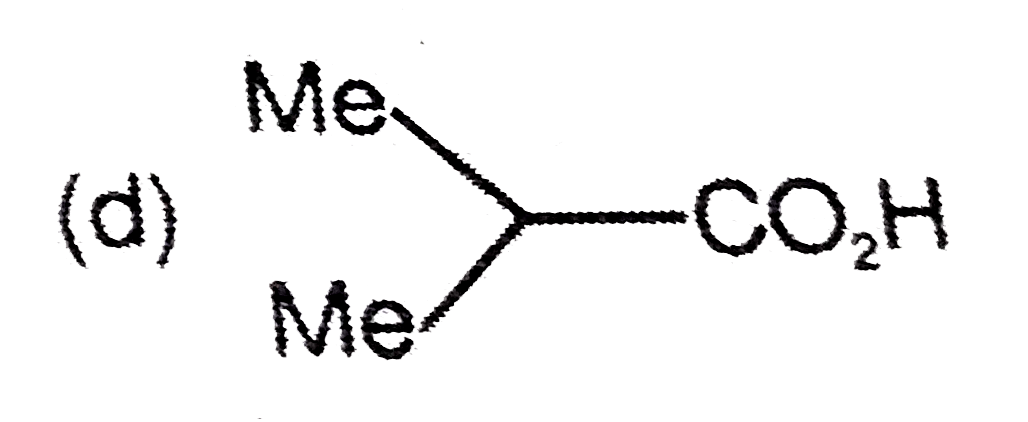Acidic strength of
(a) H3CH
(b) H2C=CH2
(c ) H-C≡C−H
is in the order of
a>b>c
b>a>c
c>b>a
a>c>b
To determine the acidic strength of the compounds H3C−CH, H2C=CH2, and H−C≡C−H, we need to analyze the stability of the conjugate bases formed after deprotonation (removal of H+). The more stable the conjugate base, the stronger the acid.
1. Identify the Compounds:
- (a) H3C−CH (which can be represented as CH3−CH2 or ethyl group)
- (b) H2C=CH2 (ethylene or ethene)
- (c) H−C≡C−H (acetylene)
2. Deprotonation of Each Compound:
- For (a) H3C−CH:
- Upon losing H+, it forms H3C−C− (a carbanion).
- For (b) H2C=CH2:
- Upon losing H+, it forms H2C=C− (a vinyl anion).
- For (c) H−C≡C−H:
- Upon losing H+, it forms H−C≡C− (an acetylenic anion).
3. Analyze the Stability of Conjugate Bases:
- (a) H3C−C−: The negative charge is on a sp³ hybridized carbon, which is less stable because it is less electronegative.
- (b) H2C=C−: The negative charge is on a sp² hybridized carbon, which is more stable than sp³ because sp² has more s-character (33%).
- (c) H−C≡C−: The negative charge is on a sp hybridized carbon, which is the most stable due to the highest s-character (50%).
4. Order of Acidic Strength:
- Since the stability of the conjugate bases is in the order of H−C≡C−>H2C=C−>H3C−C−, the acidic strength of the original compounds is in the reverse order:
- Order of acidic strength: H−C≡C−H>H2C=CH2>H3C−CH
Final Answer:
The acidic strength of the compounds is in the order:
H−C≡C−H>H2C=CH2>H3C−CH
- (a) H3C−CH (which can be represented as CH3−CH2 or ethyl group)
- (b) H2C=CH2 (ethylene or ethene)
- (c) H−C≡C−H (acetylene)
- For (a) H3C−CH:
- Upon losing H+, it forms H3C−C− (a carbanion).
- For (b) H2C=CH2:
- Upon losing H+, it forms H2C=C− (a vinyl anion).
- For (c) H−C≡C−H:
- Upon losing H+, it forms H−C≡C− (an acetylenic anion).
- (a) H3C−C−: The negative charge is on a sp³ hybridized carbon, which is less stable because it is less electronegative.
- (b) H2C=C−: The negative charge is on a sp² hybridized carbon, which is more stable than sp³ because sp² has more s-character (33%).
- (c) H−C≡C−: The negative charge is on a sp hybridized carbon, which is the most stable due to the highest s-character (50%).
- Since the stability of the conjugate bases is in the order of H−C≡C−>H2C=C−>H3C−C−, the acidic strength of the original compounds is in the reverse order:
- Order of acidic strength: H−C≡C−H>H2C=CH2>H3C−CH
The acidic strength of the compounds is in the order:
H−C≡C−H>H2C=CH2>H3C−CH
Topper's Solved these Questions
- ORGANIC CHEMISTRY : SOME BASIC PRINCIPLES AND TECHNIQUES Book:AAKASH INSTITUTEChapter:ORGANIC CHEMISTRY : SOME BASIC PRINCIPLES AND TECHNIQUES Exercise:Assignment(Section-D)(Assertion - Reason Type Questions)
Explore 12 Videos
- ORGANIC CHEMISTRY : SOME BASIC PRINCIPLES AND TECHNIQUES Book:AAKASH INSTITUTEChapter:ORGANIC CHEMISTRY : SOME BASIC PRINCIPLES AND TECHNIQUES Exercise:Assignment(SECTION B)
Explore 3 Videos
- MOCK_TEST_20Book:AAKASH INSTITUTEChapter:MOCK_TEST_20Exercise:EXAMPLE
Explore 28 Videos
- ORGANIC CHEMISTRY: SOME BASIC PRINCIPLE AND TECHNIQUESBook:AAKASH INSTITUTEChapter:ORGANIC CHEMISTRY: SOME BASIC PRINCIPLE AND TECHNIQUESExercise:TRY YOURSELF
Explore 28 Videos
Similar Questions
Arrange the following :
(i) IN increasing order of basic strength :
C6H5NH2,C6H5NH−CH3,C6H5−CH2−NH2
(ii) In increasing order of boiling point :
C4H9−NH2,(C2H5)2NH,C2H5N(CH3)2
View SolutionThe correct order of increasing acid strength of the compounds
(a) CH3COOH
(b) MeO−CH2CO2H
(c) CF3CO2H
(d)
View Solution
Knowledge Check
Basic strength of
H2CCH3
H2C=CH2
H−C≡C−HA(i)>(iii)>(ii)B(i)>(ii)>(iii)C(ii)>(i)>(iii)D(iii)>(iii)>(i)Base strength of
(i)H2C⊕CH2
(ii) H2C=⊕(CH) and
(iii) H−C≡C⊕ is in the order ofA(ii)>(i)>(iii)B(iii)>(ii)>(i)C(i)>(iii)>(ii)D(i)>(ii)>(iii)Base strength of the following
(i) H3CCH−2 , (ii) H2C=CH−
(iii) HC≡C−A(iii)>(ii)>(i)B(i)>(iii)>(ii)C(i)>(ii)>(iii)D(ii)>(i)>(iii)
The correct order of increasing acid strength of the compounds is
(a). CH3CO2H
(b). MeOCH2CO2H
(c) CF3CO2H
(d)
View SolutionThe correct order of increasing acid strength of the compounds.
(a)CH3CO2H (b)MeOCH2CO2H (c)CF3CO2H (d)
View SolutionFind the correct acidic strength order:
(i) HC≡C−COOH (ii)H2C=CH−COOH
_CHM_E01_002_Q01.png) (iv)CH3−CH2−COOH
(iv)CH3−CH2−COOH
View SolutionThe correct order of increasing acid strength of the compounds
(a)CH3CO2H (b)MeOCH2CO2H
(c)CF3CO2H

View SolutionBase strength is in the order of
(i)CH3¯¯¯CH2 (ii)H2C=ӨCHand (iii)H−C≡CӨ
View Solution